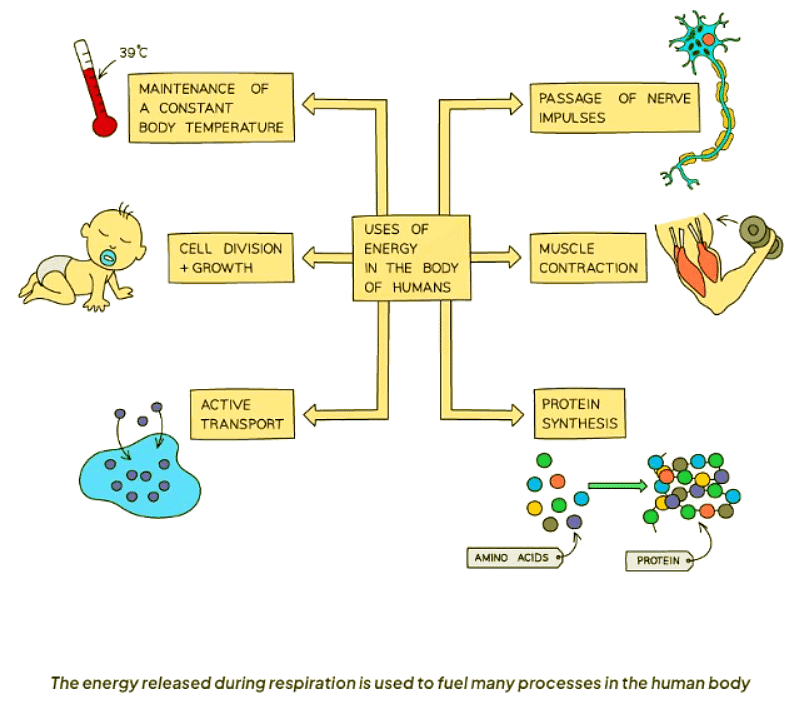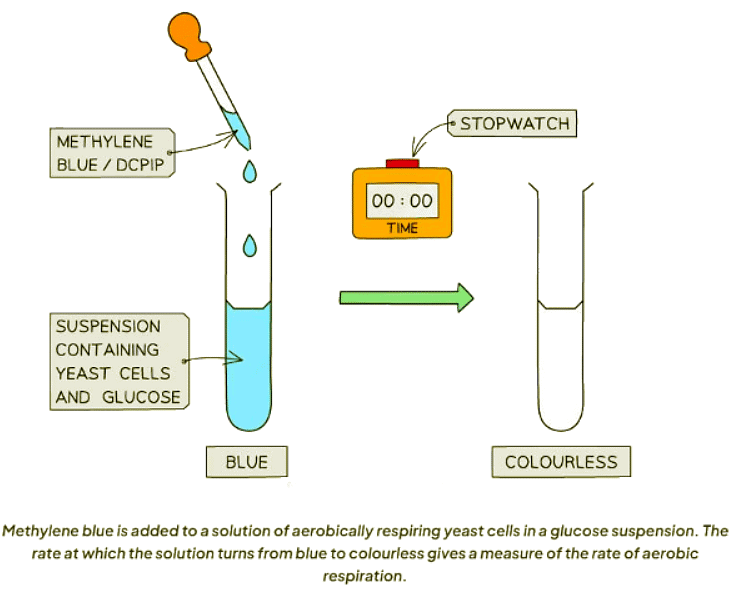Class 10 Exam > Class 10 Notes > Biology for GCSE/IGCSE > Respiration in Cells
Respiration in Cells | Biology for GCSE/IGCSE - Class 10 PDF Download
Uses of Energy in Living Organisms
- Respiration is a chemical process where nutrient molecules, particularly glucose, are broken down to release the energy stored within their bonds.
- This process is controlled by enzymes.
- Respiration can occur with oxygen (aerobic) or without oxygen (anaerobic).
- Anaerobic respiration releases much less energy per glucose molecule compared to aerobic respiration.
- Respiration happens in all living cells, with most of the chemical reactions in aerobic respiration occurring in the mitochondria.
- Energy released during respiration is essential for various processes:
- Muscle contraction
- Protein synthesis
- Cell division to create new cells
- Growth
- Active transport across cell membranes
- Generation of nerve impulses
- Maintaining a constant internal body temperature

The Effect of Temperature on Respiration
- Various experimental methods can be used to investigate the rate of respiration in organisms.
- Some methods, like the one described below, involve using a coloured indicator.
- An indicator can be used to study the effect of temperature on the rate of aerobic respiration in yeast.
- Methylene blue dye is a suitable indicator for this purpose.
- This dye can be added to a suspension of living yeast cells because it does not damage the cells.
- Yeast can respire both aerobically and anaerobically; however, this experiment focuses on their rate of aerobic respiration.
- The time taken for methylene blue to discolour (lose its colour) indicates the rate of respiration in the yeast suspension.
- The quicker the dye changes from blue to colourless, the faster the rate of respiration.
Materials Required for the Experiment:
- Yeast suspension
- Glucose solution
- Test tubes
- Stopwatch
- Methylene blue
- Temperature-controlled water bath(s)

Methylene blue is utilized in the experiment to gauge the rate of aerobic respiration in yeast cells respiring aerobically in a glucose solution. The time taken for the solution to transition from blue to colorless provides insight into the rate of respiration.
Independent and dependent variables
- The independent variable is the variable that is intentionally changed.
- In this investigation, the effect of temperature on the respiration rate in yeast is studied, so the independent variable is temperature.
- Different temperatures are achieved using water baths.
- The dependent variable is the variable that is measured and depends on the independent variable for its outcome.
- In an investigation into the effect of temperature on the rate of respiration in yeast, the rate of respiration is the dependent variable.
- The rate is measured by recording the time taken for methylene blue dye to change from blue to colourless.
Controlling other variables
When examining how one factor affects another, it's crucial to control for any additional variables that could impact the outcome. For instance:
- Volume or concentration of dye added: More dye molecules can lead to a longer time for a color change to happen.
- Volume or concentration of yeast suspension: Increased yeast cells can accelerate respiration, causing the dye to change color faster.
- Glucose concentration: Limited glucose can restrict the respiration of yeast cells in a tube.
- pH level: pH influences enzyme activity, which in turn affects respiration rate. Controlling pH using a buffer solution prevents enzyme denaturation.
Results
- A graph should be plotted that shows 'temperature' on the x-axis and 'time for colour change' on the y-axis.
- It is also possible to convert 'time for colour change' into a unit of reaction rate; this has been done in the graph shown below.
Temperature and Respiration Rate Relationship
- When the temperature increases up to 40°C, the rate of respiration also increases. This means that the time taken for the solution to become colorless decreases.
- Increasing the temperature of a solution provides the molecules in the solution with more kinetic energy. Consequently, they move around more, leading to increased collisions between enzymes and substrates involved in respiration.
Temperature Above 40°C
- As the temperature goes above 40°C, the rate of respiration decreases. Consequently, the time taken for the solution to become colorless increases.
- If the temperature is raised beyond a certain point, the enzymes participating in respiration undergo denaturation. This denaturation causes a change in the shape of their active site, making it impossible for them to form enzyme-substrate complexes.

Question for Respiration in CellsTry yourself: How does anaerobic respiration differ from aerobic respiration in terms of energy production?View Solution
The document Respiration in Cells | Biology for GCSE/IGCSE - Class 10 is a part of the Class 10 Course Biology for GCSE/IGCSE.
All you need of Class 10 at this link: Class 10
|
101 videos|193 docs|33 tests
|
FAQs on Respiration in Cells - Biology for GCSE/IGCSE - Class 10
| 1. How do living organisms use energy for respiration? |  |
Ans. Living organisms use energy for respiration to carry out essential cellular processes such as growth, repair, and reproduction. Respiration provides the necessary ATP (adenosine triphosphate) for these functions.
| 2. What is the role of respiration in the human body? |  |
Ans. Respiration in the human body is essential for providing energy for activities such as muscle contraction, nerve impulses, and maintaining body temperature. It also helps in the removal of waste products like carbon dioxide.
| 3. How does temperature affect the rate of respiration? |  |
Ans. Temperature can affect the rate of respiration in cells by influencing enzyme activity. As temperature increases, the rate of respiration also increases, up to a certain point. Beyond that point, the enzymes may denature, leading to a decrease in respiration rate.
| 4. What factors can affect respiration in yeast cells? |  |
Ans. Factors such as temperature, pH, substrate concentration, and the presence of inhibitors can affect the rate of respiration in yeast cells. These factors can either increase or decrease the efficiency of the respiration process.
| 5. How can respiration rate in yeast be investigated in a laboratory setting? |  |
Ans. Respiration rate in yeast can be investigated by measuring the production of carbon dioxide gas or the consumption of oxygen over a period of time. This can be done using a respirometer or by observing changes in the volume of a gas bubble in a graduated tube.
Related Searches




















